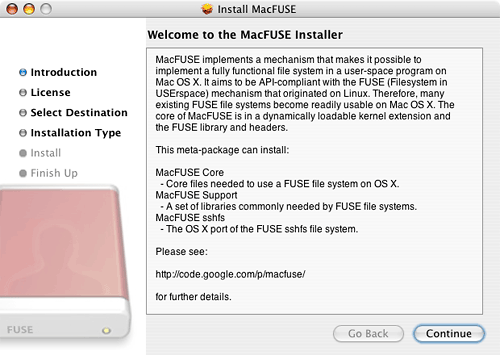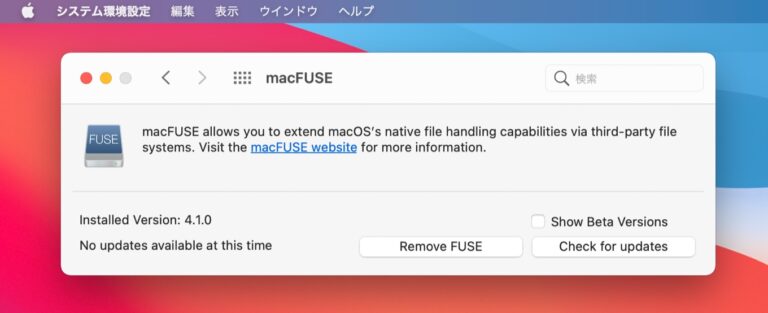

- Macfuse core mac os x#
- Macfuse core install#
- Macfuse core manual#
- Macfuse core archive#
- Macfuse core software#
If not and you see a message like, "Remote system disconnected" then try running the same command again with this debug switch after sshfs: -o sshfs_debug If it's worked you should see the volume show up in the finder. SpotlightFS exploits features unique to OS X. For everyone else, the project-supplied SpotlightFS and sshfs packages are a simpler alternative. If you intend to take that route, be sure to scour the HOWTO on the project’s wiki for hints before you start. Replace volname with the name you want to use to represent the volume as in finder. With MacFUSE Core installed, you can compile most existing FUSE filesystems from source. Replace "remotedirectory" with the directory on the remote server you want to mount and "mountpath" with the directory on your mac to use as a mount point. Sshfs /mountpath -oping_diskarb,volname=volumename The command to run sshfs to mount a server filesystem is as follows: mkdir /mountpath To do this you'll need a remote server with SSH and the SFTP extension installed. To make sure macfuse is working we can mount a remote server via SSHFS.

To pickup the changes simply close and reopen terminal or run the following command. bashrc with your favorite command line text editor and add a line like this: export PATH=$PATH:/usr/local/bin/ If /usr/local/bin isn't in the output of that command you will need to add it into your. To check this open terminal and type echo $PATH. (I would suggest renaming the old binary first before creating the symlink).Ĭurrently it's necessary to make sure that /usr/local/bin is in your path. To do this simply type: sudo ln -s /Applications/sshfs.app/Contents/Resources/sshfs-static /usr/local/bin/sshfs Note if you have a sshfs binary already installed it's recommend you do use the symlink so that you are using an up to date version of the sshfs binary. The main difference is that if you want to use the comand line version as described below you need to symlink to the sshfs binary in the sshfs.app that you will have dropped into your applications directory.
Macfuse core install#
If you want to install sshfs then you need to install the MacFUSE core as above and then install the separate sshfs package. UPDATE: The most recent versions bundle sshfs as a separate download. After installation you will need to restart your machine. Uncheck the box labeled Show Beta Versions Press Remove FUSE. Go to the Apple menu and choose System Preferences.
Macfuse core manual#
The easiest way to get macfuse running on your mac is to go and grab the dmg that contains an installer that will install the kernel extension and required libraries. There are two ways to uninstall macFUSE, manual and automatic. One of most well known FUSE filesystems is SSHFS (A filesystem that runs over SSH + SFTP) so we'll use that as an example of MacFUSE in action. A list of FUSE filesystems tested with MacFUSE is provided on the wiki. So what is FUSE?įUSE provides a easy way for anyone to create their own filesystem through providing hooks into the kernel. There will be more, no doubt, but this is my experience so far with two installations.MacFUSE is a implementation of FUSE (File-system in USErspace) that is provided via a kernel extension. (Insert expletive of choice) Checkpoint SecureRemote Client actually works if you start up with the 3 and the 2 keys depressed!ġ2. In order to have the functionality MacFUSE and NTFS-3G must.
Macfuse core software#
Install X Menu as a better way of accessing apps and documents than all the above (just a satisfied customer etc etc).ġ1. As a normal user, installing the MacFUSE software package will let you use any 3rd-party file system written on top of MacFUSE, such as NTFS-3G from Erik Larsson which will allow you to not only read NTFS volumes, but also give you the ability to write (finally) to NTFS volumes. Drag your hard drive into the sidebar in a Finder window there is no pref for showing it any other way.ġ0. Finder Prefs: attempt to make the sidebar look like something reasonable, and in an order you recognise. It's alright officer, I'll come quietly).ĩ. It seems that only by turning off the rubbish can you use a gesture for backwards and forwards in Safari (and either two or three fingers will work - I give that three thumbs up and a pinch, a spread and a squeeze at the same time. 'Pinch with thumb and three fingers'? 'Spread with thumb and three fingers'? Turn it all off. Reinstall Click to Flash extension in Safari.Ĩ. By the way, you have to get it to show the pane first. Hide the Reminders in the left pane of Mail, once you figure out how. If you need an older flavor of Java, install a VM of 10.6 server, because none of the old tricks work to get 1.4.2 going again.Ħ.
Macfuse core mac os x#
archivemount is known to work under both linux and Mac OS X (via MacFUSE). The umount (8) command performs the corresponding unmount operation.

The archives contents can subsequently be accessed inside mountpoint as a file system.
Macfuse core archive#
Drag from dock the Launchpad and Mission Control.Ĥ. The archivemount command mounts the file tree contained in the archive archivepath on the directory mountpoint.


 0 kommentar(er)
0 kommentar(er)
